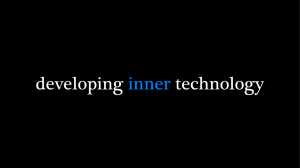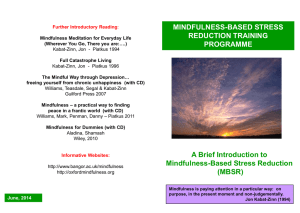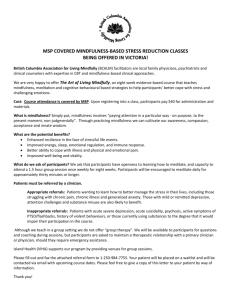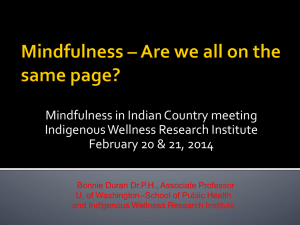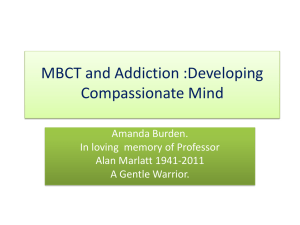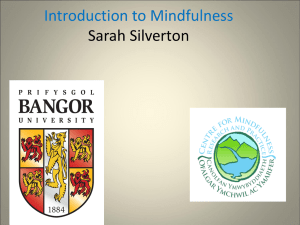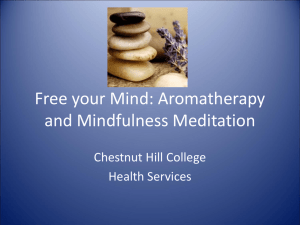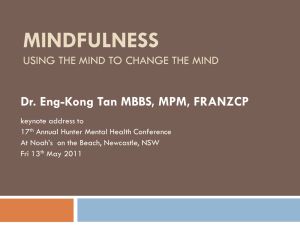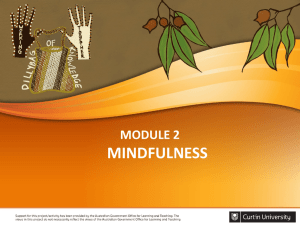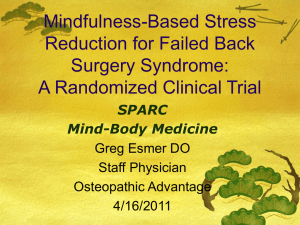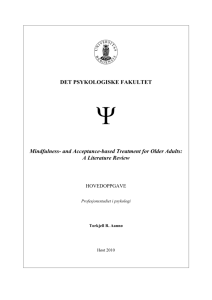Mindful self care workshop - The Adelaide Pre
advertisement
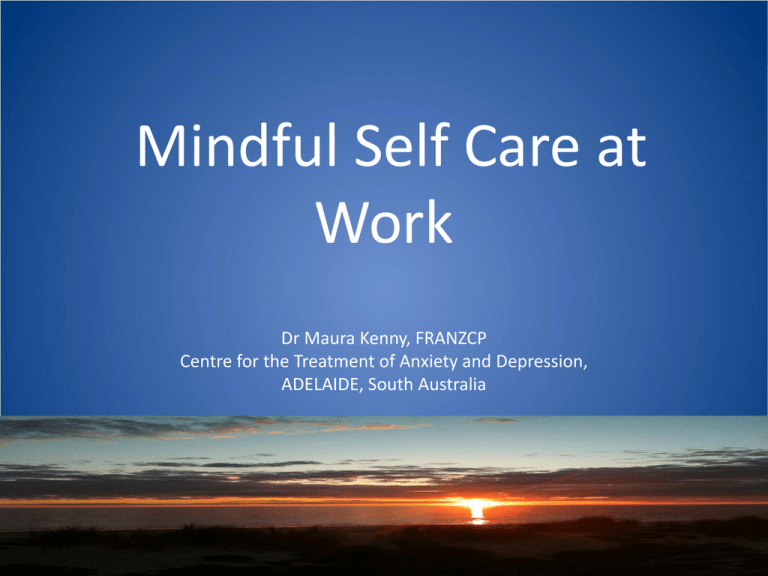
Mindful Self Care at Work Dr Maura Kenny, FRANZCP Centre for the Treatment of Anxiety and Depression, ADELAIDE, South Australia Let’s fully arrive here in this moment……. Mindfulness is a way of being aware of the present moment more fully …..and a way of ‘being with’ our experience more gently and with a sense of interest and acceptance It is not a technique to “get rid of” unpleasant mind and body states or difficult emotions (although it can often come to be used this way) An example of gentle non-judging acceptance "What day is it?" asked Pooh. "It's today," squeaked Piglet. "My favorite day," said Pooh. Organisers: AMA (state and federal), Medical Boards of A & NZ, Doctors’ Health Advisory Services, Medical Students’ Associations, RACGPs, Rural Doctors’ Workforce Agency NB No drug company sponsorship at all Sub themes of the conference were: • • • • • • • Personal approaches to staying well The Healthy workplace - corporate models Adjusting to the stages in a medical career Issues for the medical employee Managing Doctor-patients The health of medical students/young doctors Mindful self care workshop 2011 and future Conferences will be open to all health professionals “Reflection and self awareness helps physicians to…listen attentively to patients’ distress, recognise their own errors, refine their technical skills, make evidence-based decisions and clarify their values so they can act with compassion, technical competence, presence and insight.” R Epstein, JAMA, 1999 “Coping with stress appears to be one of the greatest challenges facing the medical profession” (Lee, 1987) “The current climate in health care…places an enormous burden on the clinician's shoulders. Many of the challenges of daily practice – administration, business management, psychosocial dimensions of illness and complex doctorpatient dynamics – are either absent or deprioritised in training, yet have a significant impact on the doctor's capacity to cope, and consequently to perform effectively over an extended period.” Whiteman, 2008, SA J of CPD “Burnout is very common among practising doctors (50%)” Med Board of South Australia & Doctor’s Health Working Group In 2007, beyondblue in partnership with Beaton Consulting released the Annual Professions Study. • This study found that professionals and students of those professions suffer more depressive symptoms than the general population • Lawyers and law students had four times the rate of depression cf the general population • Students had higher levels of misconceptions and negative attitudes about depression, which has implications for appropriate and timely help seeking Professor Geoff Riley MRCPsych, FRANZCP, FRACGP, FACRRM Keynote, Doctors’ Health Conference 2009 Discussed models of workplace stress: • Demand-Control Model (Karasek) • Effort-reward Imbalance (Siegrist) • Support, Instrumental and Relational Model (Karasek) Burnout Syndrome: • physical exhaustion • emotional exhaustion • emotional withdrawal • reduced interest and investment in others or work • decreased sense of personal accomplishment It is well-established that work characteristics such as high work demands, low level of decision latitude, poor work life balance and job insecurity can contribute to the onset of depression (Bonde, 2008; Couser, 2008 and Netterstram et al, 2008) High job demand, low job control ie high job strain (a combination of the two) is associated with anxiety and depressive disorders. Men with high job demands and job strain have an increased likelihood of being prescribed an antidepressant (Virtanen et al, 2007) Prevention! Discussed a number of times and as part of the new national registration for doctors in Australia, there will be provision for preventative programs in each state and jurisdiction for physical and mental health conditions beyondblue is establishing a national doctors’ mental health program Thinkwell workshops, CB Coaching and self help literature for doctors and private practitioners– Hugh Kearns and Maria Gardiner (www.ithinkwell.com.au) Anxiety! The experience of anxiety is not in itself abnormal Anxiety is a necessary prerequisite for our survival but Debilitating anxiety causes impaired performance by: - reducing the accurate appraisal of a situation - decreasing the capacity for skilled motor movements - reducing the capacity to carry out complex intellectual tasks Yerkes Dodson curve Stress Neurophysiology Acute Stress Response: • Occurs when we sense we are in danger • Fight-flight response, or fight-flight-freeze response (‘freeze’ response describes a nomovement/fade-into-the-background camouflage manoeuvre to disguise the animal until the predator moves away) • Involves the Autonomic Nervous System: - Sympathetic Nervous System fires up the body ready for action - Parasympathetic NS returns the body to the natural resting state * Brain in the palm of the hand Model (D Siegel) The SNS is stimulated via the HypothalamicPituitary-Adrenal Axis through the release of stress hormones. Cortisol and adrenaline ready the body for the immediate actions of either fight or flight Adrenaline’s effects include sweating (to cool the warmed-up body), increased heart rate and blood pressure (which gets more oxygenated blood to the muscles), increased breathing rate (to bring more oxygen to the blood), and tensed muscles (ready for flight or fight). Cortisol changes glucose metabolism to provide energy, and alters or down regulates certain systems and functions that are not immediately needed in an extreme situation (eg the immune system, digestive system, reproductive system, etc) Chronic Stress Response If we live in a state of permanent psychosocial ‘danger’ (overwork, tight deadlines, family problems, financial concerns, etc) the stress response is constantly on and the SNS is chronically aroused. What results is a flattened and raised cortisol circadian cycle, hyperactive amygdala, and hippocampal neuronal death (ie parts of the HPA and brain that are involved in mental, emotional and physical regulatory processes) This has harmful effects on the body manifesting as • muscle tension (as the energy is not expended in either fight or flight) with sore neck, tight shoulders, painful lower back/joints and headaches • lowered immune response increased heart rate and blood pressure • disturbed digestion • poor sleep Add in some major additional stress (like exams, a high stress work situation, an adverse clinical outcome, a patient complaint) and …… Stress, Exhaustion and Burnout The Exhaustion Funnel (Professor Marie Asberg) When we get tired or overwhelmed, life tends to narrow down– the range of our behavioural repertoire narrows, the spaciousness of our thinking and emotional responses restricts, and any sense of ease in our bodies tends to disappear. Flexibility, openness, ease of being and lightness tend to be replaced by a general sense of tension, tightening, tiredness and headaches. Rigid ruminative thinking and grumpy irritable responses creep in. The narrowing area of the circles illustrates the narrowing of one’s life. Worse still, we give up the things in life we enjoy and that would nourish us, leaving us only with work or tasks that often deplete our resources. Professor Asberg suggests that those of us who continue downwards are likely to be those who are the most conscientious workers, those whose self confidence is closely dependent on performance at work ie those who are seen as the best workers, not the lazy ones. The harder it is to work, the more effort is put into work, leaving even less energy and time for leisure. This results in an ever increasing accumulation of symptoms as the funnel narrows and exhaustion sets in. And worse still…….. “When we are tired, we are attacked by ideas we conquered long ago.” Nietzsche How do ideas ‘attack’ us? Relevant Cognitive Processes 1. Discrepancy Monitoring: hypervigilance for or ignoring unwanted experiences in the internal or external environment 2. Cognitive Reactivity: exaggerated negative cognitive bias if under stress 3. Anxious and Depressive Rumination: repetitive circular thinking - a futile attempt to solve the unsolvable which prolongs distressed feelings and reduces effective problem-solving 4. Experiential avoidance: suppression of difficult thoughts and feelings leads to maladaptive coping STRESS or SYMPTOMS DISCREPANCY MONITOR ON (or OFF) INCREASED CHATTER IN THE MIND (look preoccupied/on automatic pilot) COGNTIVE REACTIVITY and/or RUMINATION OLD HABITS ARE REACTIVATED WITHOUT AWARENESS AND AUTOMATICALLY judgements, comparisons, cognitive distortions; inactivity, procrastination, avoidance, etc… cascade into self maintain DEPRESSION So, what can we do about all this?........ First, become mindfully aware of what we normally do Examples of normal adaptive and not so adaptive reactions to high stress at work? Blame ourselves Blame others Give up What are our early warning signs of stress? What stops us paying attention to them? How do we remember to stay alert to the early warning signs of stress and take wise action? Cultivate mindful awareness Why meditate? Drawing on the wisdom of Buddhist psychology…. Buddhist teachings are not a religion, they are a science of mind. The Dalai Lama Four Noble ‘Truths’ from Buddhist Psychology (hypotheses to be tested not believed!) 1. There is suffering Unavoidable 2. There is a cause of suffering Attachment to having things the way we want 3. There can be an end to suffering Changing habits that create or support suffering 4. There is a path to end suffering The eightfold path Wisdom: skilful understanding skilful thought # Ethics: skilful speech skilful action # skilful livelihood Mental Discipline: skilful effort * skilful mindfulness * skilful concentration * *The mental discipline component was lifted out of Buddhist practice and incorporated in a new therapy approach called MBSR (Mindfulness-based Stress Reduction). MBCT also emphasises skilful thought and action # What is Mindfulness Meditation? (And why would we teach people to practise it?) “Mindfulness means paying attention in a particular way: on purpose, in the present moment, and non-judgementally.” (Jon Kabat –Zinn, Full Catastrophe Living, 1990) Model of Mindfulness (Shapiro et al, 2006) Attention (focus and flexibility) pf fcis Intention (eg emotional regulation) Attitude (open, curious, accepting) These three aspects of Intention, Attention, and Attitude (IAA) are not sequential but are engaged concurrently while cultivating mindfulness NB Intention changes with the clinical context “Mindfulness is basically just a particular way of paying attention.... For this reason it can be learned and practiced, as we do in the stress clinic, without appealing to Oriental culture or Buddhist authority to enrich it or authenticate it. In fact, one of its major strengths is that it is not dependent on any belief system or ideology, so that its benefits are therefore accessible for anyone to test for him or herself.” (Jon Kabat-Zinn, Full Catastrophe Living, 1990) Early applications of mindfulness meditation in mainstream health settings Mindfulness-based Stress Reduction (MBSR) first taught in the stress reduction clinic, Umass Medical Centre in 1979. Caters for those with chronic pain and physical conditions and resulting stress, anxiety and depression 8 week group program that teaches yoga and meditation, and a series of exercises designed to increase mindful awareness in everyday life, as well as of the physical condition that is causing distress. Further evolution of mindfulness-based approaches (MBAs) in mental health conditions: • Mindfulness-based Cognitive Therapy for Recurrent Depression • MBCT for Generalised Anxiety Disorder/Worry • Mindfulness-based Approach for Eating Disorders • DBT for Borderline PD • MBA for Psychosis and the Chronically Mentally Ill • MBSR for Stress in the Workplace * MBSR for stressed (non-clinical) workforce (Davidson, Kabat-Zinn et al, Psychosomatic Medicine, 2003) Those in the MBSR group showed greater LHS activation on fMRI scans of prefrontal cortex, and measurably improved immune function after 8 weeks. Moreover, the magnitude of shift on the fMRI was positively associated with the rise in antibody titre. •Rel. LHS activation ~ +ve emotional responses (approach, motivation) • Rel. RHS activation ~-ve emotional responses (avoidance, withdrawal) K Williams et al, 2001 RCT on community volunteers with high perceived stress levels. Significant reductions in: the effect of daily hassles psychological distress medical symptoms Chang et al, 2004 MBSR in College Students: reduced stress levels increased mindfulness levels increased self-efficacy levels increased positive states of mind Shapiro et al, 1998 (a) & 2005 (b) a) RCT on pre-med and medical students to Mindfulness-based Stress Reduction course or control group MBSR group showed significant reductions in: 1.state and trait anxiety 2.psychological distress, including depression Also showed significant increases in empathy levels Lasted across the exam period! b) Extended to Health Care Professionals in 2005 study: MBSR reduced stress levels, increased quality of life scores and levels of self compassion Promoting Mindfulness in Psychotherapy Trainees (PiTs) influences the treatment results of their patients Grepmair et al, 2007 Randomised double blind controlled trial 18 PiTs treating 124 patients in an IP psychotherapy unit over 9 weeks, were randomly allocated to Zen meditation practice or the control group (no meditation practice) The Zen group practised 1 hour of meditation at work Mon-Fri, 7-8am, led by a Zen Master who was unaware of the study. The therapeutic outcomes of their patients were examined and significant changes were found on a range of measures including: •Increased clarification and problem-solving abilities • Improved relaxation, stoicism and optimism levels • Greater symptom reduction on GSI and SCL-90-R MBCT for Clinicians: personal self care and professional training for health staff 8 week courses run regularly through the year and attended by a variety of health professionals in SA • Doctors (GP, Psychiatry, Anaesthetics, Palliative Care, and registrars) • Clinical and Health Psychologists • Social Workers, MH Nurses, OTs, etc • Other professionals DASS scores Preliminary data analysis: significant reductions in stress and anxiety 20 18 16 14 12 10 8 6 4 2 0 Pre-course Depression Anxiety Stress Post-course “It is self-evident that a doctor who is present and attentive to the clinical tasks at hand is more effective than a mindless one. Mindfulness, as both practice and attitude, is wellpositioned to support and broaden the internal resources of the clinician, not as prosaic navel-gazing, but rather as a clinical skill based on self awareness. This offers a means for doctors to be engaged, open and compassionate, to both themselves and their patients. In short, the clinician grounded in present-moment awareness is both good scientist and humane doctor, a condition which is congruent with the deepest values of medicine.” Whiteman, 2008, SA J of CPD Tell me, what is it you plan to do with your one wild and precious life?......... Specific CBT and Mindfulness Strategies for Wise Self Care • Nutrition, Exercise, Rest and Meditation – get the basics right • Leisure and Pleasure – recharge the batteries (without too much alcohol) and ensure there are enough nourishing activities in each day • Time management and overcoming procrastination • Accept and learn from failure while focussing on the positives Nutrition - mindful eating Exercise - how often Rest - how much Meditation - how to Mindfulness of the breath Leisure and Pleasure • recharge the batteries (without too much alcohol) • ensure there are enough nourishing activities in each day Nourishing and draining exercise Time Management: overcoming procrastination and avoidance Principles of Time Management •Decide on your goals and what you need to get done this week/semester •Plan it out/make a list and review each week – use a diary, spreadsheet, calendar on your computer but put a time next to a task on the list or it won’t happen •Break it down into small manageable bits and do it for 1/2 hour, starting with something that kicks you into action (and then motivation will follow) • Finish one task before moving to another – it’s a more efficient use of time Time Management contd. • Take breaks and plan rewards that nourish you • Review progress and re-prioritise if necessary (or omit or delegate) • Watch out for self sabotaging thoughts or behaviours • At the end of the day, congratulate yourself on what you have achieved rather than what you haven’t yet got done Men are disturbed not by things but by the view which they take of them Epictetus, 1st Century AD For there is nothing either good or bad but thinking makes it so Hamlet Act II, Scene III Thinking differently about ‘failure’ "It is impossible to live without failing at something, unless you live so cautiously that you might as well not have lived at all, in which case you fail by default.“ JK Rowling from her Harvard Acceptance Speech, 2008 (see it on you tube – it is great!) Daily Mindfulness meditation - to settle the mind and body, and recalibrate our neurophysiology 3 minute breathing space for coping – to accept what is here without pushing it away (which paradoxically allows us to cope with it) Positive Attention Training “When you go to a garden, do you look at thorns or flowers? Spend more time with roses and jasmine.” Rumi The steps are simple. Focus on positive experiences by writing down at least one thing each day under each of the following categories: 1. your competence in managing any aspect of your life eg care of the home and garden, finances, a work issue, family life, etc 1. your connectedness to others, which can include compliments and attention received but also recognising and validating your own strengths in interpersonal situations (these can often occur but are not necessarily commented on by others each time) 1. your appreciation of the world around you which includes nature, music, good food, etc This is a practice, and regular practice is needed for changes to occur and beliefs to change. Home Practice 1. Practice Mindfulness of the Breath for about 5 -10 minutes 1 -2 x daily and the 3 minute Breathing Space for coping 2. Nutrition, Exercise and Rest – get the basics right 3. Leisure and Pleasure – experiment with the ideas discussed in the Nourishing and Draining Exercise. Try increasing nourishing activities and reducing draining activities where possible. 4. Practice paying positive attention every day Thank you and keep breathing…… For information about MBCT courses and training: maura.kenny@health.sa.gov.au
